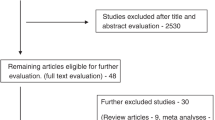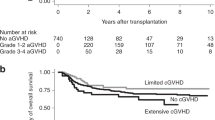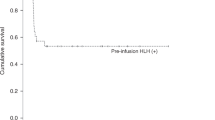Abstract
Engraftment syndrome (ES) and pre-engraftment syndrome (pre-ES) are both inflammatory conditions that occur after hematopoietic SCT (HSCT) and are characterized by non-infectious fever and skin rash. Although the pathogenesis is not fully understood, both syndromes are similar, and could be defined as a new clinical syndrome, named as peri-engraftment syndrome (peri-ES). We retrospectively analyzed the clinical records in 176 pediatric patients, following allogeneic HSCT. We utilized the definition of ES by Spitzer as the diagnostic criteria, excluding ‘within 96 h of engraftment’ criteria. Thirty cases developed peri-ES with a cumulative incidence of 17.0%. High cumulative incidence (50%) was seen in patients who underwent a double-unit cord blood transplantation (DUCBT; P<0.01). Clinical findings of peri-ES are similar, regardless of the onset day, and encephalopathy was the most severe complication. In the DUCBT cohort, the use of TBI and early complete chimerism (⩽day 21) were identified as risk factors that predispose the development of peri-ES. We determined that both, ES and pre-ES, might have similar causes, which could be included in peri-ES. Particularly, it occurred more in DUCBT patients, which means that not only neutrophil engraftment but also immune reactions within the two units might contribute to peri-ES.
This is a preview of subscription content, access via your institution
Access options
Subscribe to this journal
Receive 12 print issues and online access
$259.00 per year
only $21.58 per issue
Buy this article
- Purchase on Springer Link
- Instant access to full article PDF
Prices may be subject to local taxes which are calculated during checkout



Similar content being viewed by others
References
Spitzer TR . Engraftment syndrome following hematopoietic stem cell transplantation. Bone Marrow Transplant 2001; 27: 893–898.
Maiolino A, Biasoli I, Lima J, Portugal AC, Pulcheri W, Nucci M . Engraftment syndrome following autologous hematopoietic stem cell transplantation: definition of diagnostic criteria. Bone Marrow Transplant 2003; 31: 393–397.
Nishio N, Yagasaki H, Takahashi Y, Hama A, Muramatsu H, Tanaka M et al. Engraftment syndrome following allogeneic hematopoietic stem cell transplantation in children. Pediatr Transplant 2009; 13: 831–837.
Schmid I, Stachel D, Pagel P, Albert MH . Incidence, predisposing factors, and outcome of engraftment syndrome in pediatric allogeneic stem cell transplant recipients. Biol Blood Marrow Transplant 2008; 14: 438–444.
González-Vicent M, Ramírez M, Sevilla J, Pérez A, Fernández S, Madero L et al. Engraftment syndrome after autologous peripheral blood progenitor cell transplantation in pediatric patients: a prospective evaluation of risk factors and outcome. Bone Marrow Transplant 2004; 34: 1051–1055.
Foncillas MA, Diaz MA, Sevilla J, Gonzalez Vicent M, Fernandez-Plaza S, Perez A et al. Engraftment syndrome emerges as the main cause of transplant-related mortality in pediatric patients receiving autologous peripheral blood progenitor cell transplantation. J Pediatr Hematol Oncol 2004; 26: 492–496.
Carreras E, Fernández-Avilés F, Silva L, Guerrero M, de Larrea CF, Martínez C et al. Engraftment syndrome after auto-SCT: analysis of diagnostic criteria and risk factors in a large series from a single center. Bone Marrow Transplant 2010; 45: 1417–1422.
Patel KJ, Rice RD, Hawke R, Abboud M, Heller G, Scaradavou A et al. Pre-engraftment syndrome after double-unit cord blood transplantation: a distinct syndrome not associated with acute graft-versus-host disease. Biol Blood Marrow Transplant 2010; 16: 435–440.
Frangoul H, Wang L, Harrell FE, Ho R, Domm J . Preengraftment syndrome after unrelated cord blood transplant is a strong predictor of acute and chronic graft-versus-host disease. Biol Blood Marrow Transplant 2009; 15: 1485–1488.
Wang X, Liu H, Li L, Geng L, Ding K, Liu X et al. Pre-engraftment syndrome after unrelated donor umbilical cord blood transplantation in patients with hematologic malignancies. Eur J Haematol 2012; 88: 39–45.
Lee YH, Lim YJ, Kim JY, Kim YD, Lee SW . Pre-engraftment Syndrome in Hematopoietic Stem Cell Transplantation. J Korean Med Sci 2008; 23: 98–103.
Kim H, Shin D, Lee JW, Jang MK, Park KD, Shin HY et al. Successful empirical antifungal therapy of intravenous itraconazole with pharmacokinetic evidence in pediatric cancer patients undergoing hematopoietic stem cell transplantation. Blood (ASH Annual Meeting Abstracts) 2011; 118: 3019.
Kang HJ, Shin HY, Choi HS, Ahn HS . Fludarabine cyclophosphamide plus thymoglobulin conditioning regimen for unrelated bone marrow transplantation in severe aplastic anemia. Bone Marrow Transplant 2004; 34: 939–943.
Kang HJ, Kho SH, Jang MK, Lee SH, Shin HY, Ahn HS . Early engraftment kinetics of two units cord blood transplantation. Bone Marrow Transplant 2006; 38: 197–201.
Park M, Koh KN, Kim BE, Im HJ, Park KD, Kang HJ et al. The impact of HLA matching on unrelated donor hematopoietic stem cell transplantation in Korean children. Korean J Hematol 2011; 46: 11–17.
Przepiorka D, Weisdorf D, Martin P, Klingemann HG, Beatty P, Hows J et al. 1994 Consensus Conference on Acute GVHD Grading. Bone Marrow Transplant 1995; 15: 825–828.
Sullivan KM, Agura E, Anasetti C, Appelbaum F, Badger C, Bearman S et al. Chronic graft-versus-host disease and other late complications of bone marrow transplantation. Semin Hematol 1991; 28: 250–259.
Kang HJ, Yoo KH, Lee JW, Kim H, Lee SH, Sung KW et al. Double umbilical cord blood transplantation for children and adolescents. Ann Hematol 2010; 89: 1035–1044.
de Pagter PJ, Schuurman R, Meijer E, van Baarle D, Sanders EAM, Boelens JJ . Human herpesvirus type 6 reactivation after haematopoietic stem cell transplantation. J Clin Virol 2008; 43: 361–366.
Sideri A, Neokleous N, De La Grange PB, Guerton B, Le Bousse Kerdilles MC, Uzan G et al. An overview of the progress on double umbilical cord blood transplantation. Haematologica 2011; 96: 1213–1220.
Barker JN . Transplantation of 2 partially HLA-matched umbilical cord blood units to enhance engraftment in adults with hematologic malignancy. Blood 2004; 105: 1343–1347.
Gutman JA, Turtle CJ, Manley TJ, Heimfeld S, Bernstein ID, Riddell SR et al. Single-unit dominance after double-unit umbilical cord blood transplantation coincides with a specific CD8+ T-cell response against the nonengrafted unit. Blood 2009; 115: 757–765.
Majhail NS, Brunstein CG, Wagner JE . Double umbilical cord blood transplantation. Curr Opin Immunol 2006; 18: 571–575.
Acknowledgements
This study was supported by a grant of the Korea Healthcare Technology R&D Project, Ministry of Health & Welfare, Republic of Korea (A102065) and by a grant (11172KFDA288) from Korea Food & Drug Administration in 2011.
Author information
Authors and Affiliations
Corresponding author
Ethics declarations
Competing interests
The authors declare no conflict of interest.
Rights and permissions
About this article
Cite this article
Hong, K., Kang, H., Kim, N. et al. Peri-engraftment syndrome in allogeneic hematopoietic SCT. Bone Marrow Transplant 48, 523–528 (2013). https://doi.org/10.1038/bmt.2012.171
Received:
Revised:
Accepted:
Published:
Issue Date:
DOI: https://doi.org/10.1038/bmt.2012.171
Keywords
This article is cited by
-
Engraftment syndrome after allogeneic stem cell transplantation: a systematic review and meta-analysis
Bone Marrow Transplantation (2023)
-
Understanding and treatment of cutaneous graft-versus-host-disease
Bone Marrow Transplantation (2023)
-
Critically ill allogenic HSCT patients in the intensive care unit: a systematic review and meta-analysis of prognostic factors of mortality
Bone Marrow Transplantation (2018)
-
Prognostic factors and outcomes for pediatric patients receiving an haploidentical relative allogeneic transplant using CD3/CD19-depleted grafts
Bone Marrow Transplantation (2016)
-
Dexamethasone palmitate for patients with engraftment syndrome is associated with favorable outcome for children with hematological malignancy
Bone Marrow Transplantation (2016)



